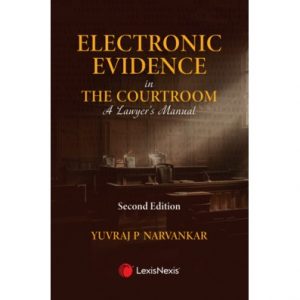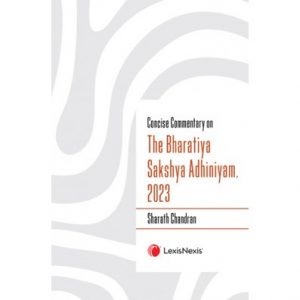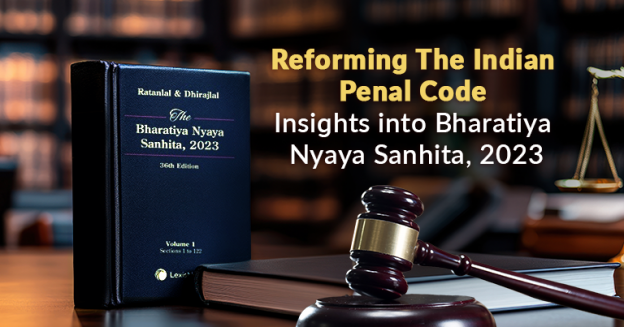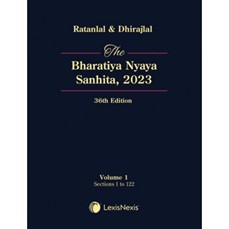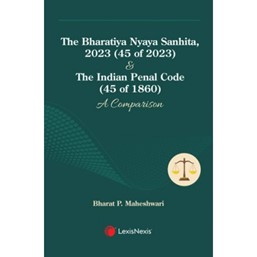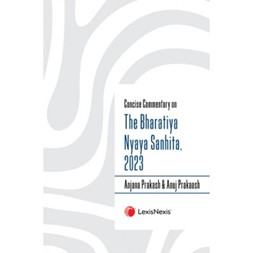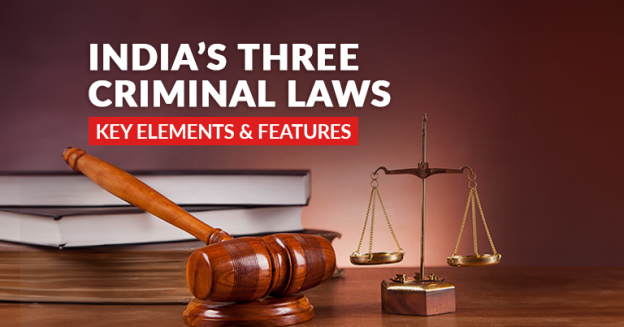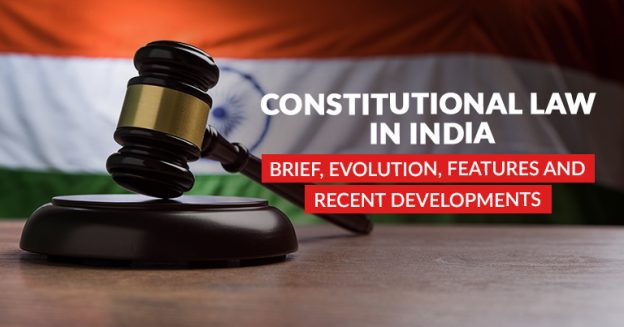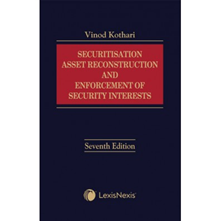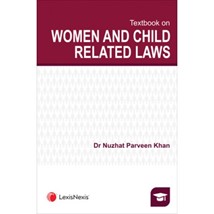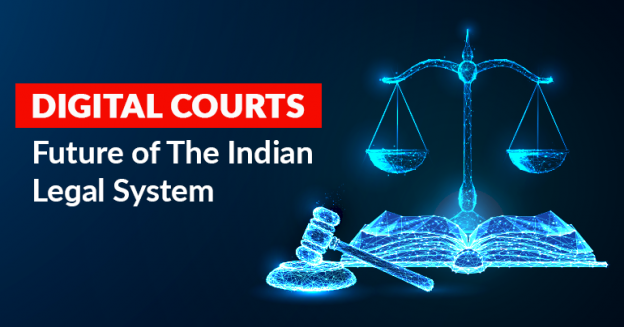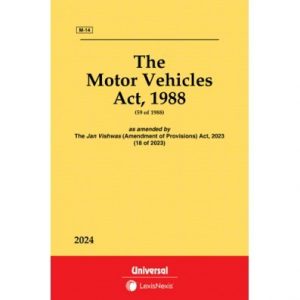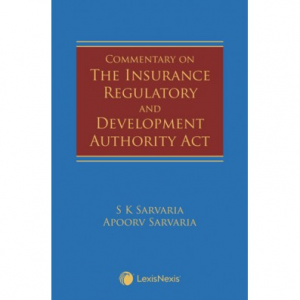Introduction
Marking a significant reform and change in India’s criminal law justice system, the old criminal laws were repealed and replaced by three new laws. The new criminal laws came into legal effect from July 1, 2024.
This blog ahead offers significant legal insights into the important features and legal provisions of the Bharatiya Nagarik Suraksha Sanhita, 2023 along with a comparative outlook over the changes in the procedure of the Bharatiya Nagarik Suraksha Sanhita, 2023 (BNSS) vis-à-vis and The Code of Criminal Procedure, 1973 (Cr.P.C). The piece explores the legal impact & consequences that flow from these changes.
Decoding the Need for Reform & Bharatiya Nagarik Suraksha Sanhita,2023
If we look back, the society, legal aspects, socio-economic outlook, criminality, justice, the valuation and consumption of time and technology amongst many other things, have evolved and grown in terms of their implication and meaning.
After all these years, there were various concerns at hand, procedural lapses, complexity and stringency, huge pendency, low rate of conviction in criminal cases, lack of inculcation of technological advancements and consequent delay or failure of the criminal justice system.
Hence, there was a need to reform the criminal justice system- so that it could effectively adapt to these new-age changes and modern technology and advancements.
Bharatiya Nagarik Suraksha Sanhita, 2023
Bharatiya Nagarik Suaksha Sanhita, 2023(BNSS), the law that replaces the old The Code of Criminal Procedure 1973 (Cr.P.C)- operates on the fundamentals of good governance, speedy trial and effective justice translated via robust procedural mechanism and timelines.
It is termed as ‘ An Act to consolidate and amend the laws relating to criminal procedure’. Adding to this, the new Bharatiya Nagarik Suraksha Sanhita has been updated and amended to suit and adapt to the new vision of the criminal justice system, reformation, protection of citizens and technological shift and evolution.
Essential Features and Provisions of the Bharatiya Nagarik Suraksha Sanhita, 2023-
- Structure- The Code of Criminal Procedure consisted of- 37 Chapters, 484 Sections and 2 Schedules. Now, the Bharatiya Nagarik Suraksha Sanhita consists of – 39 Chapters, 531 Sections, and 2 schedules.
- Procedural Law- The Bharatiya Nagarik Sraksha Sanhita, deals with the procedural aspect of the criminal law in the courts and its functioning. Hence it deals with all the aspects related to the procedure followed in criminal cases. Illustratively, inquiry, timelines, bail, cognizance, arrest and appeals.
- Citizen’s First -Approach- The Bharatiya Nagarik Suraksha Sanhita (BNSS) has been designed and framed with a citizen-centric approach in its procedure and legal effect. The vision behind the functionality of the criminal justice system and the expected outcome has changed and has taken a citizen-centric approach. The title itself consists of the terms ‘Nagarik’ (i.e. citizens) and ‘Suraksha’ (i.e. protection), hence asserting how this law caters to the safety and empowerment of citizens, as a whole.
- 2(1)(a)- Audio-Video Electronic Means– The BNSS, 2023 – has adopted and inculcated the changes as per the digital transformation and technological advancements and hence audio-video devices have a newly found essential place in various procedures involved in criminal law and courts. S.2(1)(a) expressly defines the audio-video electronic means as – the use of any communication device (note- this widens the ambit and includes any form or mode of communication device that can be used for the given purposes) for the purposes of video conferencing, recording of processes of identification, search and seizure or evidence, the transmission of electronic communication and for such other purposes and by such other means as the State Government may provide (note- Again by using the terms like ‘any other purposes’ and ‘any other means’ the law widens the scope of its applicability to include any new form or method that might develop or evolve with time and hence takes into consideration the fast-evolving nature of the technology and possible future advancements).
- Forensic Science– An Aid In Investigation- Section 176(3)- The science and forensic science have developed remarkably in terms of both means and effect. Investigation is an essential process and step in the criminal justice system, as the collection of pieces of evidence and hence an effective trial against the crime in question substantially rests on the investigation itself. A scientific approach to the investigation enhances the effectiveness and precision of the elements involved or the evidence collected during the investigation. It even has the capacity to increase the ambit of what can be effectively derived and used as evidence, which might have gone unnoticed by the naked eye. Section 176(3) of BNSS provides for the use of forensic science in investigation – it mandates the visit by forensic expert to the crime scene for collection of forensic evidence, in case of an offence punishable for seven years or more and also recording of the process via videography on mobile phone or any other electronic device (This would be effective from the date, as would be notified within a period of five years by the State Government- this lends the states time to develop and establish the requisite machinery for effective implementation of this mandate).
If the forensic facility is not available then the State Government will notify the utilization of such facility of any other suitable state, until the required facility is developed or made in that particular State. - Speedy Trial & Specific Timeline- Bharatiya Nagarik Suraksha Sanhita, with an aim to strive towards speedy & fair trial and speedy justice, provides for various stringent timelines to complete various steps or processes and hence aims to address the issue of delay and pendency.
To count a few-
Section 173(3) – deals with preliminary inquiry in cases of cognizable offences punishable with 3 years or more but for less than 7 years- the preliminary inquiry is to be conducted within 14 days- to see if a prima facie case exists or not.
Section 184- that deals with the medical examination of an alleged rape or attempted rape victim. Section 184 (3)- provides that the medical report has to be forwarded by the practitioner to the Investigation Officer within 7 days.
Section 230- Bharatiya Nagarik Suraksha Sanhita prescribes a period of a maximum of 14 days (without undue delay) from the date of appearance or production of the accused, for providing a copy of relevant documents to the victim and the accused (For proceedings instituted on police report). This provision is similar to Section 207 of old Cr.P.C, however, the new provision provides for a specific timeline of compliance and now the copies of documents are also to be provided to the victim, along with the accused.
Section 258 which deals with Session court trials, mandates delivery of judgment within a period of 30 days from the date of completion of the arguments. This period can be further extended by 15 days i.e. to a maximum of 45 days with reasons. - Advances in the Usage of Digital and Electronic Means- The Bharatiya Nagarik Suraksha Sanhita, has taken due note of the advancement of technology and hence has brought in effective legal provisions to use electronic and digital means, as required. This increases the speed, functionality and precision of the process and results. Illustratively, if a process is recorded as a video, it significantly reduces the chances of tampering or false manual records.
E.g. Section 105 of BNSS provides for recording of search and seizure through audio-video means. Section 185(2) provides for an audio-video recording of the search conducted by the police officer and the proviso to Section 185(2) adds that such a recording shall be preferably made by a mobile phone.
There have been instances where electronic means have been adopted for ease, better accessibility or that would effectively enhance the speed of the procedure. Illustratively, Section 230 (similar to the old Section 207 of Cr.P.C)- dealing with the supply of copies of documents to the accused and the victim, has an added proviso- according to which supply of these documents via electronic means will also be recognized as the proper compliance of the mandate of Section 230.
Section 530 which is a new addition in itself, provides for discretionary conduct of all trials, inquiries and proceedings in electronic mode, via modes of electronic communication or any audio-video electronic means (the provision uses the term-‘may’- as it allows trials, inquiries and proceedings to be held via electronic mode). This provision emphasizes on the significant inclusion of technological advancements and digital means into the criminal justice system to improve accessibility and efficient functioning of the system. - Power of Sentencing- Bharatiya Nagarik Suraksha Sanhita has incorporated some changes regarding the sentencing power of the Magistrates. Section 23 of BNSS provides that a Judicial Magistrate of First Class (JMFC) can pass a sentence for imprisonment up to 3 years or a maximum fine of Rs.50,000 or both or community service (As per the old Cr.P.C the power of fine was upto Rs. 10,000 and there was no provision for community service).
As for Judicial Magistrate of Second Class (JMSC) – they can pass a sentence up to an imprisonment of 1 year or a fine of maximum Rs.10,000 or both or community service (As per old Cr.P.C-this power of imposing fine was limited up to Rs.5000/- and there was no such provision of community service).
As per, Section 25 of BNSS that deals with a conviction for more than one offence under one trial- the provision has been changed as compared to the old Cr.P.C- Earlier, in case of non-mentioning in the judgment by the court, there was a presumption for the punishments imposed to run consecutively. However, as per BNSS, there is a mandate that the courts shall consider the gravity of the offence while deciding on this aspect and shall mention if the punishments are to run concurrently or consecutively.
Moreover, Proviso (a) to Section 25(2)- states that in case of consecutive sentences, no convict shall be sentenced to imprisonment for a period longer than 20 years, in aggregate (earlier as per Cr.P.C this was capped at 14 years). - Attendance of Witness– The investigation officer has the power to call any person who seems to be acquainted with the facts and circumstances of the case in question. Earlier Section 160 Cr.P.C dealt with this power. Now Section 179 of BNSS deals with this power and has introduced a few changes. The old provision exempted any man below the age of 15 years or above the age of 65 years from attending before the investigating officer at any place other than his residence. However, the new provision reduced the age to 60 years instead of 65 years and extends this exemption to a person with acute illness as well.
Adding to this, a new proviso has been added (i.e. Section 179(1))- according to which if the people exempted from appearance before the investigating officer, at any place other than their residence, are willing to appear at the police station itself, then based on their choice they can be permitted for such an appearance on the orders of the concerned investigating officer. - Handcuffing- The Code of Criminal Procedure as such had no provision or power for using handcuffs or handcuffing an accused or arrested person. However, Bharatiya Nagarik Suraksha Sanhita (BNSS) now confers statutory power to use handcuffs, as Section 43(3) of BNSS deals with the power to use handcuffs. The said provision confers a subjective and discretionary power on the police officer as it uses the word-‘may’, for a police officer to decide on the usage of handcuffs. This usage in itself is against Article 14, 19 and 21 of the Indian Constitution and is against human dignity.
Section 43(3) states that ” The police officer may, keeping in view the nature and gravity of the offence, use handcuff while effecting the arrest of a person who is a habitual, repeat offender who escaped from custody, who has committed offence of organised crime, offence of terrorist act, drug related crime, or offence of illegal possession of arms and ammunition, murder, rape, acid attack, counterfeiting of coins and currency notes, human trafficking, sexual offences against children, offences against the State, including acts endangering sovereignty, unity and integrity of India or economic offences”. - Mandatory Summary Trial-(Section 283 to 288 of BNSS)- Chapter 22 of The Bharatiya Nagarik Suraksha Sanhita (BNSS) deals with the procedural aspect of summary trials. Earlier Chapter 21 of Cr.P.C dealt with it. The new provision has a legal mandate to try the listed offences as per the summary procedure, as now the new provision under Section 283 of BNSS uses the word –’shall’ instead of the term – ‘may’ which was used in the old legal provision. Moreover, the value of the property (which is the subject matter of the listed offences) under the provision has been increased to a maximum of Rs. 20,000/- in place of the old maximum limit of Rs. 2000/-. Section 283(2) provides that the magistrate may in his discretion (after hearing the accused in this concern) try summarily all or any of the offences which are not punishable with death, life imprisonment or imprisonment exceeding 3 years (earlier in Cr.P.C it was limited to offences not punishable with death, life imprisonment or imprisonment exceeding 2 years).
Moreover, the decision of magistrate to try a case summarily under Section 283(2) is not appealable.
Significant Deletions
- 144A- The provision dealing with the power to prohibit carrying arms in procession or mass drill or mass training with arms.
- Metropolitan Magistrates- Courts of Metropolitan Magistrates that were established for the metropolitan area as per Section 16 of Cr.P.C, do not exist as per BNSS.
- Metropolitan Areas- defined under Section 2(k)- as areas so declared under Section 8 of Cr.P.C, have been removed.
- Posts of Assistant Session Judge- Section 9(3) that dealt with the appointment of Assistant Session Judges under Cr.P.C, no longer finds reference under the BNSS.
Challenges Ahead
- Section 23- Community Service– Explanation to Section 23(3) explains that it is a sentence where the court can order for performance of work (that would benefit the community) without remuneration. However, there are no specifics or explanations regarding the timeline, administration, or the specific nature of work or tasks that may fall under the sentence of community service. This leaves a subjective gap in the procedural and substantive aspects of the issue.
- Unfettered power to use handcuffs– Section 43(3) grants handcuffing powers to the police in certain cases. To list a few- considering the nature and gravity of the offence, repeat offenders, habitual offenders, or in cases of sexual offences or drug-related crimes. The Bharatiya Nagarik Suraksha Sanhita (BNSS) via this provision gives subjective, discretionary and unchecked powers to the police to use handcuffs in the wide list of cases in the provision. Adding to this the process of handcuffs has been often criticised as being unconstitutional and violative of human rights and dignity.
- Lack of Infrastructure- The new provisions of BNSS (Bharatiya Nagarik Suraksha Sanhita) have been drafted to be inclusive of recent technological, digital and medical advancements, as discussed above. However, factually there is a need to exhaustively develop and upgrade the supporting infrastructure and human resources and training, that can effectively make these changes or inclusions functional. Illustratively, electronic trials or proceedings would need a strong internet network, supportive hardware, accessibility and machinery and the understanding of its functioning by various stakeholders involved in the process. Another significant example is what devices and the lack of availability or specific guidelines over the devices that can be used for audio-video recording in investigation or cases of search and seizure. Usage of personal mobile phones or devices may raise a question of authenticity, safekeeping, technical or personal glitches. The functional efficacy of this process and the lacunas or documentary gaps it might create in the process, are to be looked into.
- The authenticity of digital records and electronic evidence and the technological understanding- The electronic evidence or digital records in the new age developments and the unprecedented evolution that lies ahead, are at times vulnerable to tampering or derailing. The courts and the people involved will need special understanding and training to deal with these aspects and glitches. These evidences have to be stringently scrutinized and should have a complete chain of authenticity.
- Electronic FIR- Section 173(1)(ii) provides for the registration of electronic FIR by the informant, which is to be signed within a period of 3 days by the informant. However, there is no subsequent guideline or provision to deal with instances of non-signing or delay in signing, and its legal consequences.
- Preliminary Inquiry vs. Mandate of FIR- Section 173(3)- Section 173(3) of the BNSS now allows for a preliminary inquiry by the officer-in-charge (on approval of DSP) in a given time frame of 14 days. This preliminary inquiry is to check for the existence of a prima facie case, on receiving an information of the commission of an offence which is punishable for imprisonment of three years or more and less than seven years.
This leaves wide discretion on the officers to opt for conducting a preliminary inquiry, before proceeding with the investigation. Moreover, this provision seems to be in direct conflict with the Supreme Court’s direction in the Lalita Kumari vs. State of UP (2013 INSC 748), which imposed a legal obligation of registration of FIRs on receipt of a complaint of a cognizable offence. This confers excessive and unchecked discretionary powers on the police officers and leaves the scope of corruption and delay in the investigation or registration of FIR. - Section 187(2)- Default Bail- The new provision of BNSS now grants the police the authority to hold an accused in the police custody for up to fifteen days, whether in one stretch or in intervals, within a sixty- or ninety-day detention period allowed for respective offences under Section 187.
Earlier, Section 167(2) of the Code of Criminal Procedure (CrPC) which dealt with the aspect of default bail, provided for police custody only during the initial fifteen days of arrest.
Critics have expressed due concerns that this provision is prone to misuse and may be used as a deliberate means to avoid bail- if a suspect is proposed to be released on bail anytime during the sixty- or ninety-day period, the police could resist the application in the court on pretext of need of police custody. This seems to be a major issue, considering the under-trial prisoners, over-crowded prisons and pendency are already a concern.
In conclusion, The Bharatiya Nagarik Suraksha Sanhita (BNSS) has been objectively drafted to suit and adopt the changes brought in by time, the leap of technological & medical advancements and the changing purview towards the criminal justice system.
The procedural law and procedure laid down are bound to face impediments in the functional application, as the future or various permutations are not precisely perceivable and the solution would lie in marking and adapting to the requisite improvements in infrastructure, functioning, and factual requirements that would present themselves on a real-time basis.
The BNSS has been drafted and is to be applied to work towards a citizen-centric justice system, while balancing the rights of the accused, victim and an equitable society.
To know more about The Bharatiya Nagarik Suraksha Sanhita, 2023 and for an exhaustive coverage, refer to-
The Bharatiya Nagarik Suraksha Sanhita (BNSS) , 2023 (46 of 2023)-
The Bharatiya Nagarik Suraksha Sanhita repealed The Code of Criminal Procedure. To know the legal provisions and the basics bare act is a necessary legal resource for professionals, academicians and students alike. The bare act lays down all the provisions of the BNSS alongwith the reference to the old provisions for easy navigation.
Ratanlal & Dhirajlal: The Bharatiya Nagarik Suraksha Sanhita, 2023
The trusted and authoritative classic, methodically analyzes the provisions of The Bharatiya Nagarik Suraksha Sanhita, 2023 with necessary reference to the old provisions of the Code of Criminal Procedure, 1973. It highlights the changes, new provisions and omissions, along with landmark cases and recent judgments. It ensures that spirit and essence of the original work is maintained, preserving its relevance and applicability to both the Act and the BNSS.
As the readers and professionals navigate from old to the new provision, a comparative outlook is sure to be of best use. A reliable source of reference which serves the dual purpose at one place, with comparative charts and highlighted differences between the BNSS and the old provisions of Cr.P.C.
Concise Commentary on The Bharatiya Nagarik Suraksha Sanhita, 2023
The exhaustive commentary is a crisp and authoritative resource book with insightful details and has been structured as a handy guide lying between bare act and a voluminous commentary. The commentary comes with a comparative contextual reference to the old law i.e. Code of Criminal Procedure (Cr.P.C).

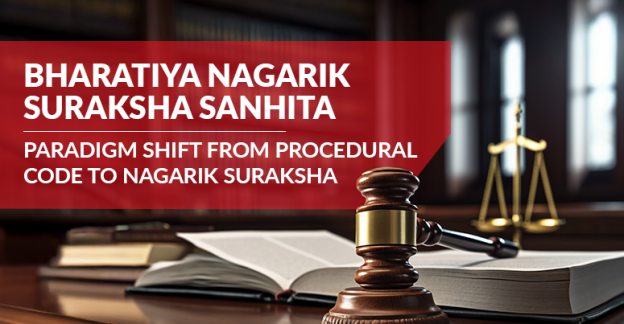




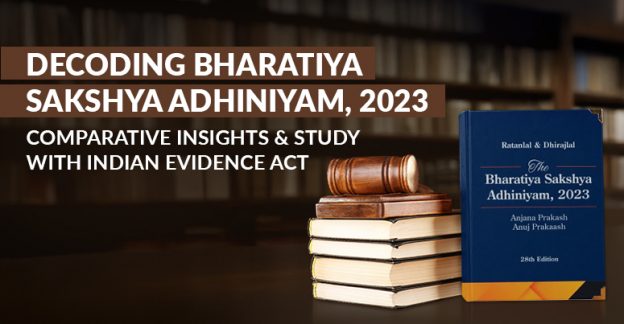
 The Bare Act is a basic and essential requisite for academicians, students, researchers, professionals and judicial officers alike.
The Bare Act is a basic and essential requisite for academicians, students, researchers, professionals and judicial officers alike.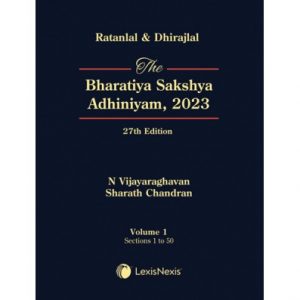
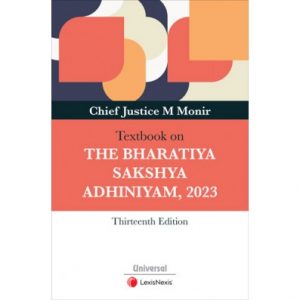
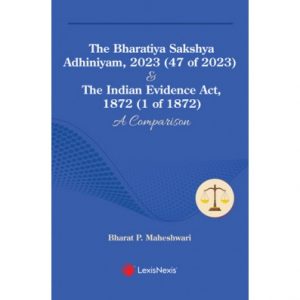 The commentary provides insights into the changes brought in by The Bharatiya Sakshya Adhiniyam. It comes with comparative charts highlighting amendments and changes.
The commentary provides insights into the changes brought in by The Bharatiya Sakshya Adhiniyam. It comes with comparative charts highlighting amendments and changes.